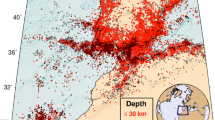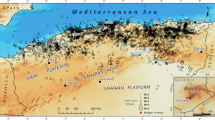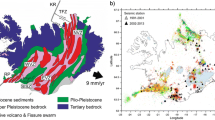Abstract
In 1991, a new seismic monitoring network named SIL was started in Iceland with a digital seismic system and automatic operation. The system is equipped with software that reports the automatic location and magnitude of earthquakes, usually within 1–2 min of their occurrence. Normally, automatic locations are manually checked and re-estimated with corrected phase picks, but locations are subject to random errors and systematic biases. In this article, we consider the quality of the catalogue and produce a revised catalogue for South Iceland, the area with the highest seismic risk in Iceland. We explore the effects of filtering events using some common recommendations based on network geometry and station spacing and, as an alternative, filtering based on a multivariate analysis that identifies outliers in the hypocentre error distribution. We identify and remove quarry blasts, and we re-estimate the magnitude of many events. This revised catalogue which we consider to be filtered, cleaned, and corrected should be valuable for building future seismicity models and for assessing seismic hazard and risk. We present a comparative seismicity analysis using the original and revised catalogues: we report characteristics of South Iceland seismicity in terms of b value and magnitude of completeness. Our work demonstrates the importance of carefully checking an earthquake catalogue before proceeding with seismicity analysis.











Similar content being viewed by others
References
Ambraseys, N.N., and Sigbjörnsson, R. (2000), Re-Appraisal of the Seismicity of Iceland, Polytechnica-Engineering Seismology, No. 3, Earthquake Engineering Research Centre, University of Iceland.
Angelier, J., Slunga, R.F., Bergerat, F., Stefansson, R., and Homberg, C. (2004), Perturbation of stress and oceanic rift extension across transform faults shown by earthquake focal mechanisms in Iceland, E.P.S.L., 219, 271–284.
Antonioli, A., Belardinelli, M. E., Bizzari, A., and Vogfjörd K. S. (2006). Evidences of instantaneous triggering during the seismic sequence of year 2000 in south Iceland. J. Geophys. Res., 111. doi:10.1029/2005JB003935.
Árnadóttir, T.H., Geirsson, H., and Einarsson P. (2004). Coseismic stress changes and crustal deformation on the Reykjanes Peninsula due to triggered earthquakes on June 17, 2000. J. Geophys. Res., 109, B09307. doi:10.1029/2004JB003130.
Bergerat, F., and Angelier, J. (2000), The South Iceland Seismic Zone: tectonic and seismotectonic analyses revealing the evolution from rifting to transform motion, Journal of Geodynamics, 29, 211–231.
Böðvarsson, R., Rögnvaldsson, S.T., Jakobsdóttir, S.S., Slunga, R., and Stefánsson, R., (1996), The SIL data acquisition and monitoring system, Seism. Res. Lett., 67, 35–46.
Böðvarsson, R., Rögnvaldsson, S.T., Slunga, R., and Kjartansson, E. (1999), The SIL data acquisition system-at present an beyond year 2000, Phys. Earth Planet. Inter., 113, 89–101.
Bondar, I., Myers, S.C., Engdahl, E.R., and Bergman, E.A. (2004), Epicentre accuracy based on seismic network criteria, Geophys. J. Int., 156, 483–496.
Castellaro, S., Mulargia, F., and Kagan, Y.Y. (2006), Regression problems for magnitudes, Geophys. J. Int., 165, 913–930. doi:10.1111/j.1365-246X.2006.02955.x.
Clifton, A. E., Pagli, C., Jónsdóttir, J. F., Eythórsdóttir, K., and Vogfjörd, K. (2003). Surface effects of triggered fault slip on Reykjanes Peninsula, SW Iceland. Tectonophysics, 369, 145–154.
Clifton, A., and Einarsson P. (2005). Styles of surface rupture accompanying the June 17 and 21, 2000 earthquakes in the South Iceland Seismic Zone. Tectonophysics, 396, 141–159.
Clifton, A.E., and Kattenhorn, S.A. (2006), Structural architecture of a highly oblique divergent plate boundary segment, Tectonophysics, 419, 27–40.
Decriem, J., Árnadóttir, T., Hooper, A., Geirsson, H., Sigmundsson, F., Keiding, M., Ófeigsson, B.G., Hreinsdóttir, S., Einarsson, P., Lafemina, P., and Bennett, R.A. (2010). The 2008 May 29 earthquake doublet in SW Iceland, Geophys. J. Int. (2010) 181, 1128–1146. doi: 10.1111/j.1365-246X.2010.04565.x.
Dziewonski, A.M., Chou, T.A., and Woodhouse, J.H. (1981), Determination of earthquake source parameters from waveform data for studies of global and regional seismicity, J. Geophys. Res., 86, 2825–2852. doi:10.1029/JB086iB04p02825.
Einarsson, P. (1991), Earthquakes and present-day tectonism in Iceland, Tectonophysics, 189, 261–279.
Einarsson, P. (2008), Plate boundaries, rifts and transforms in Iceland, JÖKULL, 58, 35–58.
Einarsson, P., Björnsson, S., Foulger, G., Stefánsson, R. and Skaftadóttir, T. (1981) Seismicity Pattern in the South Iceland Seismic Zone, in Earthquake Prediction (eds D. W. Simpson and P. G. Richards), American Geophysical Union, Washington, D. C. Maurice Ewing Series 4, 141–151, doi:10.1029/ME004p0141.
Ekström, G., Nettles, M., and Dziewonski, A.M. (2012), The global CMT project 2004-2010: Centroid-moment tensors for 13,017 earthquakes, Phys. Earth Planet. Inter., 200–201, 1–9. doi:10.1016/j.pepi.2012.04.002.
Eshaghi, A., Tiampo, K.F., Ghofrani, H., and Atkinson, G.M. (2013), Using Borehole Records to Estimate Magnitude for Earthquake and Tsunami Early-Warning Systems, Bull. Seismol. Soc. Am., 103(4), 2216–2226. doi:10.1785/0120120319.
Everitt, B.S. (2005), An R and S-PLUS companion to multivariate analysis, Springer: London, p. 221.
Feigl, K.L., Gasperi, J., Sigmundsson, F., and RIGO, A. (2000). Crustal deformation near Hengill volcano, Iceland 1993–1998: Coupling between magmatic activity and faulting inferred from elastic modelling of satellite radar interferograms. J. Geophys. Res., 105 (B11), 25655–25670.
Gomberg, J.S., Shedlock, K.M., and Roecker, S.W. (1990), The effect of S-Wave arrival times on the accuracy of hypocenter estimation, Bull. Seism. Soc. Am., 80, 1605–1628.
Gudmundsson, G.B., Vogfjörd, K.S. and Thorbjarnardóttir, B.S. (2006). SIL data status report, in: PREPARED – third periodic report, February 1, 2005 – July 31, 2005. R. Stefánsson et al. (Eds.). Icelandic Meteorological Office report, no 06008, VI-ES-05, Appendix 3, pp 127–131.
Gulia, L., Wiemer, S., and Wyss, M. (2012), Catalog artifacts and quality controls, Community Online Resource for Statistical Seismicity Analysis. doi:10.5078/corssa-93722864. http://www.corssa.org.
Gutenberg, R., and Richter, C.F. (1944), Frequency of earthquakes in California, Bulletin of the Seismological Society of America, 34, 185–188.
Habermann, R.E. (1987), Man-made changes of seismicity rates, Bull. Seism. Soc. Am., 77 (1), 141–159.
Hackman, M.C., King, G.C.P., and Bilham, R. (1990), The mechanics of the South Iceland Seismic Zone, Journal of Geophysical Research. doi:10.1029/90JB01043.
Hjaltadóttir, S. (2009) Use of relatively located microearthquakes to map fault patterns and estimate the thickness of the brittle crust in Southwest Iceland. Sub-surface fault mapping in Southwest Iceland, Master’s thesis, Faculty of Earth Sciences, University of Iceland, pp. 104. ISBN 978-9979-9914-6-5. http://hdl.handle.net/1946/3990.
Hjaltadottir, S., Vogfjord, K. S., and Slunga, R. (2005), Mapping subsurface faults in southwest iceland using relatively located microearthquakes, Geophysical research abstracts, 7, 06664.
Husen, S., and Hardebeck, J.L. (2010), Earthquake location accuracy, Community Online Resource for Statistical Seismicity Analysis. doi:10.5078/corssa-55815573. http://www.corssa.org.
Jakobsson, S.P., Honsson, J., and Shido, F. (1978), Petrology of the western Reykjanes Peninsula, Iceland, Journal of Petrology, 19, 669–705.
Keiding, M., Árnadóttir, TH., Sturkell, E., Geirsson, H., and Lund, B. (2008). Strain accumulation along an oblique plate boundary: The Reykjanes Peninsula, southwest Iceland. Geophys. J. Int., 172(1):861–872. doi:10.1111/j.1365-246X.2007.03655.x.
Legrand, D., Villagómez, D., Yepes, H., and Calahorrano, A. (2004) Multifractal dimension and b value analysis of the 1998–1999 Quito swarm related to Guagua Pichincha volcano activity, Ecuador, J. Geophys. Res., 109, B01307. doi:10.1029/2003jb002572.
Lin, T., and Wu, Y.M. (2010), Magnitude determination using strong ground motion attenuation in earthquake early warning, Geophys. Res. Lett., 7, L07304. doi:10.1029/2010GL042502.
Madigan, D., Bartlett, P., Bühlmann, P., Carroll, R., Murphy, S., Roberts, G., Scott, M., Távare, S., Triggs, C., Wang, J-L., Wasserstein, R., and Zuma, K. (2014), Statistics and science: a report of the London Workshop on the Future of the Statistical Sciences. http://bit.ly/londonreport. last accessed 31 July 2014.
Mignan, A., Woessner, J. (2012), Estimating the magnitude of completeness for earthquake catalogs, Community Online Resource for Statistical Seismicity Analysis. doi:10.5078/corssa-00180805. http://www.corssa.org.
Pétursson, G.G. and Vogfjörd, K.S. (2009), Attenuation relations for near- and far field peak ground motion (PGV, PGA)and new magnitude estimates for large earthquakes in SW-Iceland, Icelandic Meteorological Report no VI 2009-012, pp 43. ISSN 1670-8261.
Roth, F. (2004), Stress Changes Modelled for the Sequence of Strong Earthquakes in the South Iceland Seismic Zone Since 1706. Pure & Applied Geophysics, 161, 1305–1327.
Rögnvaldsson, S.T. and SLUNGA, R. (1993), Routine fault plane solutions for local networks: A test with synthetic data, Bull. Seismol. Soc. Am., 83(4), 1232–1247.
Schorlemmer, D., and Woessner, J. (2008), Probability of detecting an earthquake, Bull. Seismol. Soc. Am., 98(5), 2103–2117. doi:10.1785/0120070105.
Slunga, R., Norrman, P., and Glans, A. (1984), Seismicity of Southern Sweden – Stockholm: Försvarets Forskningsanstalt, FOA Report, C2 C20543-T1, 106 pp.
Stefánsson, R., Böðvarsson, R., Slunga, R., Einarsson, P., Jakobsdóttir, S.S., Bungum, H., Gregersen, S., Havskov, J., Hjelme, J., and Korhonen, H. (1993), Earthquake prediction research in the South Iceland seismic zone and the SIL project, Bull. Seism. Soc. Am., 83, 696–716.
Storchak, D.A., Di Giacomo, D., Bondár, I., Engdahl, E.R., Harris, J., Lee, W.H.K., Villaseñor, A., and Bormann, P. (2013). Public Release of the ISC-GEM Global Instrumental Earthquake Catalogue (1900–2009), Seism. Res. Lett., 84(5), 810–815. doi:10.1785/0220130034.
Tormann, T., Wiemer, S., Hauksson, E. (2010). Changes in reporting Rates in the Southern California Earthquake Catalog, Introduced by a New Definition of Ml, Bull. Seism. Soc. Am., 100(4), 1733–1742.
Utsu, T. (1965), A method for determining the b-value in a formula logN = a−bm showing magnitude frequency relation for earthquakes, Hokkaido Univ. Geophys. Bull., 13, 99–103, in Japanese with English abstract.
Vogfjörd, K.S., Kjartansson, E., Slunga, R., Halldórsson, P., Hjaltadóttir, S., Gudmundsson, G.B., Sveonbjörnsson, H., Ármannsdóttir, S., Thorbjarnardóttir B., and Jakobsdóttir, S. (2012). Development and implementation of seismic early warning processes in South-west Iceland, Icelandic Meteorological Report n° VI 2010-012, pp 83. ISSN 1670-8261.
Wason, H.R., Das, R., and Sharma M.L. (2012), Magnitude conversion problem using general orthogonal regression, Geophys. J. Int., 190(2), 1091–1096.
Wiemer, S., and Baer, M. (2000), Mapping and removing quarry blast events from seismicity catalogs, Bull. Seism. Soc. Am., 90, 525–530.
Wiemer, S., and Wyss, M. (2000), Minimum magnitude of completeness in earthquake catalogs: examples from Alaska, the Western United States, and Japan, Bull. Seism. Soc. Am., 90, 859–869.
Woessner, J., and Wiemer, S. (2005), Assessing the quality of earthquake catalogues: Estimating the magnitude of completeness and its uncertainty, Bull. Seismol. Soc. Am., 95. doi:10.1785/012040007.
Wyss, M., Hasegawa, A., Wiemer, S. and Umino, N. (1999), Quantitative mapping of precursory seismic quiescence before the 1989, M 7.1, off-Sanriku earthquake, Japan, Annali di Geophysica, 42, 851–86.
Zuniga, F.R., and Wyss, M. (1995), Inadvertent changes in magnitude reported in earthquake catalogs: their evaluation through b-value estimates, Bull. Seism. Soc. Am., 85, 1858–1866.
Acknowledgments
This study was supported with funds provided by the European project REAKT Strategies and tools for Real-Time EArthquake RisK ReducTion. All the maps and graphics were obtained through open-source and freely available matlab code MapSeis, that can be downloaded from http://www.corssa.org/mapseis. The authors wish to thank the Guest Editor Prof. Jiancang Zhuang, Dr. Marie Keiding and an anonymous reviewer for constructive comments which contributed to improve the quality of the paper. The authors are also grateful to the Icelandic Meteorological Office for providing access to the SIL catalogue data.
Author information
Authors and Affiliations
Corresponding author
Rights and permissions
About this article
Cite this article
Panzera, F., Zechar, J.D., Vogfjörd, K.S. et al. A Revised Earthquake Catalogue for South Iceland. Pure Appl. Geophys. 173, 97–116 (2016). https://doi.org/10.1007/s00024-015-1115-9
Received:
Revised:
Accepted:
Published:
Issue Date:
DOI: https://doi.org/10.1007/s00024-015-1115-9




